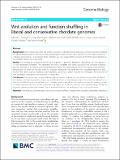Wnt evolution and function shuffling in liberal and conservative chordate genomes
Abstract
Background: What impact gene loss has on the evolution of developmental processes, and how function shuffling has affected retained genes driving essential biological processes, remain open questions in the fields of genome evolution and EvoDevo. To investigate these problems, we have analyzed the evolution of the Wnt ligand repertoire in the chordate phylum as a case study. Results: We conduct an exhaustive survey of Wnt genes in genomic databases, identifying 156 Wnt genes in 13 non-vertebrate chordates. This represents the most complete Wnt gene catalog of the chordate subphyla and has allowed us to resolve previous ambiguities about the orthology of many Wnt genes, including the identification of WntA for the first time in chordates. Moreover, we create the first complete expression atlas for the Wnt family during amphioxus development, providing a useful resource to investigate the evolution of Wnt expression throughout the radiation of chordates. Conclusions: Our data underscore extraordinary genomic stasis in cephalochordates, which contrasts with the liberal and dynamic evolutionary patterns of gene loss and duplication in urochordate genomes. Our analysis has allowed us to infer ancestral Wnt functions shared among all chordates, several cases of function shuffling among Wnt paralogs, as well as unique expression domains for Wnt genes that likely reflect functional innovations in each chordate lineage. Finally, we propose a potential relationship between the evolution of WntA and the evolution of the mouth in chordates.
Citation
Somorjai , I M L , Marti-Solans , J , Diaz-Gracia , M , Nishida , H , Imai , K , Escriva , H , Cañestro , C & Albalat , R 2018 , ' Wnt evolution and function shuffling in liberal and conservative chordate genomes ' , Genome Biology , vol. 19 , 98 . https://doi.org/10.1186/s13059-018-1468-3
Publication
Genome Biology
Status
Peer reviewed
ISSN
1474-760XType
Journal article
Description
IS was supported by the European Union Horizon 2020 research and innovation programme under grant agreement numbers 654428 (“CORBEL”). HN was supported by Grants in Aid from The Japan Society for The Promotion of Science (22370078, 15H04377) and The Ministry of Education, Culture, Sports, Science and Thechnology, Japan (23112714, 25113518). KI was supported by a Grant in Aid from the Japan Society for the Promotion of Science (26711014). HE was supported by ANR-16-CE12-0008-01 grant from Agence Nationale de la Recherche. CC was supported by BFU2016-80601-P. RA was supported by BIO2015-67358-C2-1-P grant from Ministerio de Economía y Competitividad (Spain). CC and RA were also supported by grants BFU2010-14875 from Ministerio de Ciencia e Innovación (Spain), and SGR2014-290 and SGR2017-1665 from Generalitat de Catalunya.Collections
Items in the St Andrews Research Repository are protected by copyright, with all rights reserved, unless otherwise indicated.

